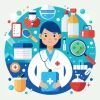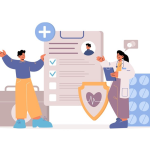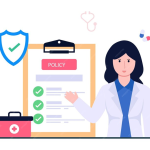
Key Functions Of Electronic Health Records in Modern Healthcare
Electronic Health Records (EHRs) have transformed modern healthcare, offering numerous benefits for both patients and providers. By digitizing patient information, EHRs enhance care quality, improve efficiency, and streamline operations. This article delves into the essential functions of EHRs and their significant impact on the healthcare industry
Key Functions of Electronic Health Records
Electronic Health Records (EHRs) have become a cornerstone of modern healthcare delivery. To understand their transformative impact, we’ll delve into the key functions of EHR systems and their benefits for patients and providers.
1. Centralized Patient Information
One of the most significant functions of an electronic health record is the centralization of patient information. EHRs store all patient data in a single, easily accessible digital format.
This eliminates the need for paper records and ensures that healthcare providers have access to up-to-date patient information whenever needed.
Benefits of Centralized Patient Information
- Enhanced Coordination: Different departments and specialists can access the same patient data, ensuring coordinated and consistent care.
- Improved Accuracy: Reduces the chances of errors that can occur with handwritten records.
- Time-Saving: Quick access to patient history speeds up decision-making and treatment processes.
2. Improved Patient Care
Electronic health records play a crucial role in improving patient care. With comprehensive and accurate patient data, healthcare providers can make better-informed decisions.
How EHRs Improve Patient Care
- Real-Time Data Access: Providers can access patient records in real-time, ensuring they have the most current information.
- Evidence-Based Decisions: EHRs provide access to clinical guidelines and research, supporting evidence-based practice.
- Preventive Care: EHRs can alert providers about preventive care measures, such as vaccinations and screenings.
3. Enhanced Communication
Effective communication is critical in healthcare. EHRs facilitate seamless communication between healthcare providers, patients, and other stakeholders.
Communication Enhancements
- Provider-to-Provider: EHRs allow different healthcare providers to share patient information quickly and efficiently.
- Provider-to-Patient: Patients can access their health records and communicate with their providers through patient portals.
- Interdisciplinary Collaboration: EHRs support collaboration among various healthcare professionals, leading to comprehensive care plans.
4. Increased Efficiency
EHRs significantly increase the efficiency of healthcare operations. They streamline administrative tasks, reduce paperwork, and enhance workflow.
Efficiency Gains
- Automated Processes: EHRs automate scheduling, billing, and coding, reducing administrative burdens.
- Quick Information Retrieval: Healthcare providers can quickly retrieve patient information, reducing wait times and improving service delivery.
- Resource Management: EHRs help in managing resources like staff, equipment, and facilities more effectively.
5. Enhanced Data Security
Data security is paramount in healthcare. Electronic health records offer robust security features to protect patient information.
Security Features
- Encryption: EHRs use encryption to protect data from unauthorized access.
- Access Controls: Only authorized personnel can access specific parts of the EHR, ensuring privacy.
- Audit Trails: EHRs maintain logs of who accessed or modified patient data, enhancing accountability.
6. Clinical Decision Support
Clinical decision support (CDS) systems integrated with EHRs assist healthcare providers in making informed decisions.
CDS Features
- Alerts and Reminders: EHRs can alert providers about potential drug interactions, allergies, and other critical information.
- Diagnostic Support: EHRs provide diagnostic support tools, helping providers identify conditions and recommend treatments.
- Guideline Adherence: EHRs ensure adherence to clinical guidelines and protocols, promoting standardization of care.
7. Patient Involvement
EHRs empower patients by involving them in their care. Through patient portals, individuals can access their health records, schedule appointments, and communicate with their providers.
Patient Empowerment
- Access to Records: Patients can view their health information, lab results, and medication lists.
- Appointment Management: Patients can schedule and manage their appointments online.
- Health Education: EHRs provide educational resources, helping patients understand their conditions and treatments.
8. Data Analytics
EHRs support data analytics, which can lead to improved patient outcomes and operational efficiency.
Analytics Applications
- Population Health Management: EHRs analyze data to identify trends and manage population health.
- Performance Metrics: Healthcare facilities can track performance metrics and identify areas for improvement.
- Research and Development: EHR data supports clinical research, leading to advancements in medical knowledge and treatments.
Conclusion
Electronic health records have revolutionized modern healthcare. By centralizing patient information, improving care, enhancing communication, increasing efficiency, ensuring data security, supporting clinical decisions, involving patients, and enabling data analytics, EHRs play a crucial role in delivering high-quality healthcare.
As technology continues to evolve, the importance and functionality of electronic health records will only grow, further transforming the healthcare landscape.
Frequently Asked Questions (FAQs)
What Is An Electronic Health Record?
An electronic health record (EHR) is a digital version of a patient’s paper chart, containing comprehensive health information.
How Do EHRs Improve Patient Care?
EHRs improve patient care by providing real-time access to accurate patient information, supporting evidence-based decisions, and facilitating preventive care.
What Security Measures Are In Place For EHRs?
EHRs use encryption, access controls, and audit trails to protect patient data and ensure privacy.
How Do EHRs Enhance Communication In Healthcare?
EHRs facilitate seamless communication between healthcare providers, patients, and other stakeholders, promoting coordinated and comprehensive care.
Can Patients Access Their Electronic Health Records?
Yes, patients can access their EHRs through patient portals, allowing them to view their health information and communicate with their providers.
Enhance Patient Care and NABH Compliance with LazyMonkey
LazyMonkey is your all-in-one solution for improving patient care, retaining more patients, and meeting NABH standards. Our powerful QR-based feedback tool enables you to capture real-time insights from patient feedback, discharge surveys, staff and doctor evaluations, and clinical research, while also streamlining inter-departmental communication.
Transform your healthcare facility today - reach out to us at hello@lazymonkey.in, or request a demo here!
Elevate Your Restaurant Experience with LazyMonkey
LazyMonkey’s QR-based feedback system helps you gather real-time insights from customers, track satisfaction levels, and enhance the dining experience. Get instant feedback on your menu, service, and ambience, and make data-driven improvements to boost repeat customers and reviews.
Improve your restaurant today – reach out to us at hello@lazymonkey.in, or request a demo here!
Empower Student Engagement and Campus Improvement with LazyMonkey
LazyMonkey offers a seamless way to gather student feedback, track satisfaction, and enhance campus life. From course evaluations to dorm feedback, our QR-based solution makes it easy to capture valuable insights and improve student retention.
Upgrade your university experience – contact us at hello@lazymonkey.in, or request a demo here!
Streamline Feedback and Drive Performance Across Your Enterprise/Franchise with LazyMonkey
Whether you manage one or multiple locations, LazyMonkey’s QR-based feedback system helps you gather real-time employee and customer feedback. Improve operational efficiency, track satisfaction, and make data-driven decisions to enhance brand consistency and growth.
Transform your franchise today – reach out to us at hello@lazymonkey.in, or request a demo here!
Enhance Customer Satisfaction and Service Standards in Banking with LazyMonkey
LazyMonkey empowers banks to capture real-time feedback from clients across branches. Improve customer experience, assess service quality, and ensure regulatory compliance with our QR-based solution, helping you retain clients and meet banking standards.
Elevate your bank’s customer care – contact us at hello@lazymonkey.in, or request a demo here!
Boost Customer Engagement and Mall Satisfaction with LazyMonkey
LazyMonkey’s QR-based feedback tool enables you to collect feedback from shoppers, track satisfaction, and enhance the mall experience. Gather insights on store services, cleanliness, and entertainment to create an unmatched customer journey.














